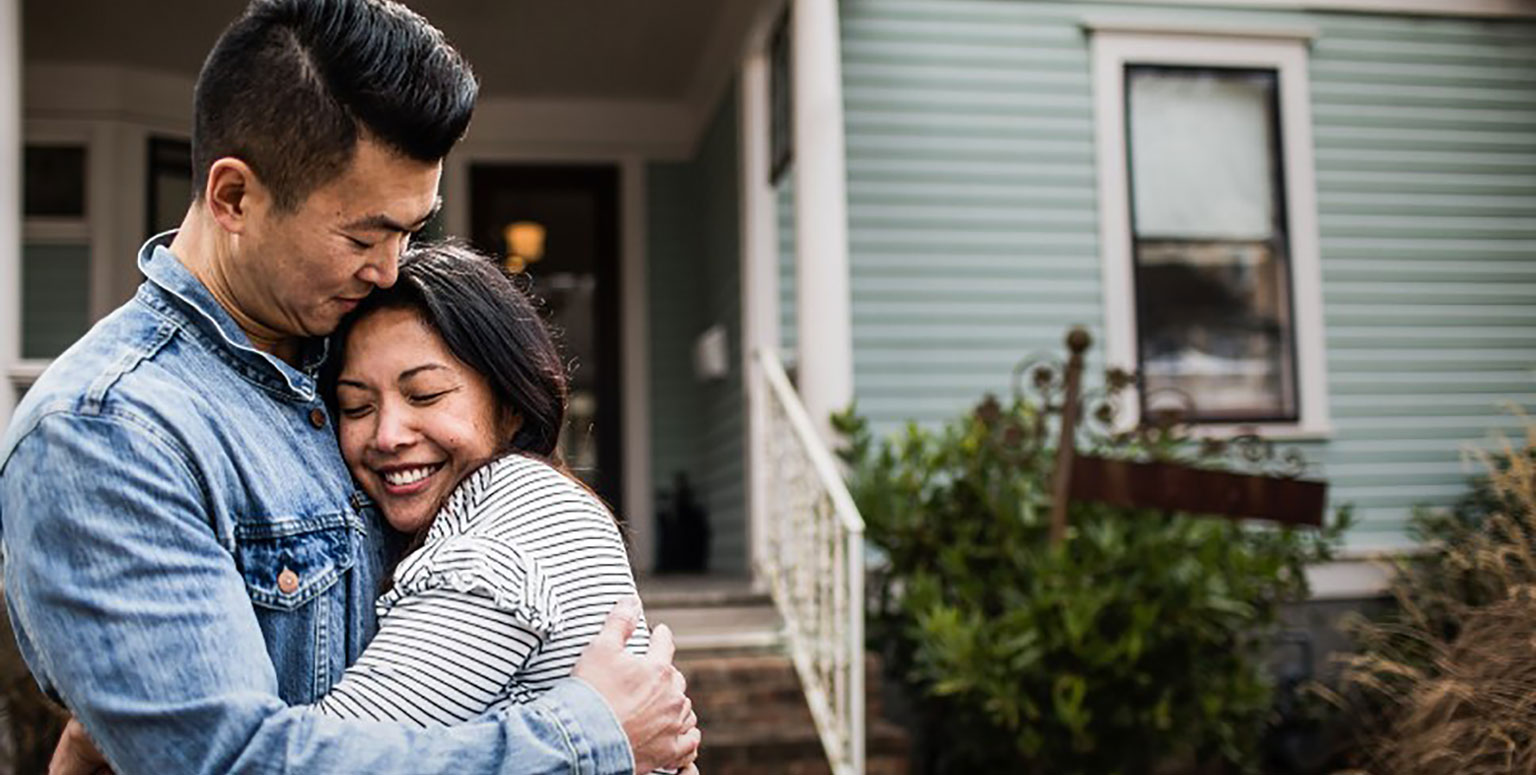There’s no denying Australians have a love affair with property. Around two-thirds of us are homeowners1 and for many, buying a home is a lifelong dream.
It’s also the most expensive purchase many people will ever make, so given the stakes, it pays to do your research and understand what’s involved in the buying process before making a leap into the property market.

Before you start
The first step in buying a property is to prepare, by making sure your financial situation will enable you to make the purchase. To get your finances in order it’s a good idea to have a budget, establish a savings goal and work out how much you can afford to save each week, fortnight or month towards buying a house. As most people need a home loan to finance their purchase, engage with your lender or mortgage broker early to see how much you can afford to borrow. This is known as pre-approval.
What is pre-approval?
It’s where the lender assesses your financials and provides you with a figure you may be able to borrow. The process can take some time and effort. While getting pre-approval can be a useful step, it’s important to note it’s not a guarantee that your home loan application will be approved. Pre-approvals are intended to be a guide that your application fits the lender’s criteria. You’ll still need to get full, unconditional approval before committing to a property purchase.
You’ll also need to have a good idea of where you want to buy and the state of the property market in your preferred location. One of the best ways to do this is to browse popular house sales sites on the internet, which can give you a good insight into purchase prices in different parts of Australia.
Choosing what to buy
Deciding what type of property to buy will depend on several factors such as your budget, lifestyle, personal taste and whether you’re buying a property to live in or as an investment property. Below are some of the pros and cons associated with different property types.
Buying land and building a house
Pros:
- You can choose the size and position of your block of land, the design of your house and customise the interiors to your own tastes.
- New builds are typically more energy-efficient than existing properties, which could save you money in the long run.
- Some state governments offer extra financial incentives to home buyers, including first home buyers, who build a property rather than buy an existing one.
- You’ll pay for the construction in stages, which can give you extra time to save.
- Your new house will come with a warranty, which should give you some protection for structural defects for a number of years – it differs from state-to-state.
Cons:
- The potential for construction delays may mean the house could end up costing more than expected, and you may not be able to borrow the additional money from your lender.
- Having your building design approved by the local council can be a time-consuming process.
- Rather than being able to move in soon after your purchase, you’ll have to wait until your house is built.
- You could be at risk of an unfinished property if your builder falls into bankruptcy.
Buying a house and land package
Pros:
- Generally, when you buy a house and land package stamp duty is only payable on the land, not the house.
- The developer will assist with council approval, making this process easier.
- It’s usually cheaper than buying land and building a house separately.
- You can lock in the property at today’s prices and by the time you move in, it may have gone up in value.
Cons:
- In many parts of metropolitan Australia vacant land tends to be a fair distance from the major cities.
- You may be limited by the developer in the number of housing designs you can choose from.
- Essential infrastructure such as shops, schools, childcare, health facilities and transport links may not have been built in the area yet.
- New housing estates tend to offer smaller block sizes than established homes.
- Sometimes additional costs such as landscaping, fencing and driveways are not included in the purchase price, so it’s important to read the contract carefully.
- You could be living surrounded by construction for some time as other houses are built in the area.
Buying an off-the-plan apartment, townhouse or villa
Pros:
- You only need to pay the deposit upfront, giving you longer to save before the settlement date.
- You can lock in the property at today’s prices and by the time you move in, it may have increased in value.
- In limited circumstances, and subject to you meeting relevant criteria, stamp duty may only be payable on the value of the land in some states.
- You might be able to choose fixtures and fittings to customise the property to your tastes.
- You don’t have to worry about council approvals, which will be taken care of by the developer.
Cons:
- If property prices fall during construction you may end up having to pay more than the property is worth and your lender may be unwilling to loan you the amount they’d previously agreed to.
- If the developer falls into bankruptcy you could lose your deposit and be left with an unfinished property.
- Construction could take longer than expected.
- You may not like the finished property.
Buying an established house
Pros:
- You can move into the property sooner – typically the settlement date is one to three months after you agree to buy the property.
- You can see what you’re buying upfront.
- Buying a house in an established area should mean essential infrastructure, transport links and shops are already in place nearby.
Cons:
- There are some upfront costs to consider such as obtaining building and pest reports. These could also uncover problems with the property that you need to fix if you decide to purchase the property.
- Some fittings and fixtures may not be included in the sale, so be sure to read the contract of sale thoroughly.
- You may need to change the interiors to update the property or to suit your tastes.
Buying an established apartment, townhouse or villa
Pros:
- These types of properties are usually smaller in size than a house, and on a smaller block of land, so they can be lower maintenance than a house.
- They are built with adjoining walls. This can be a benefit if you like the security and social aspects of having neighbours close by.
Cons:
- Apartment, townhouse or villa complexes typically have strata fees that you’ll need to factor into your ongoing costs.
- You’ll likely share at least one common wall with your neighbour so there’s a risk of noise transfer.
- There may be rules in the strata bylaws that limit what you can do to the property.
Ways to buy
Properties for sale are typically listed as either private sale or for auction. There are some important differences between the two.
Private sale
A property being sold by private treaty or sale will have an asking price, or an offers-over price. There is no official end date to the sales campaign, so buying a home this way will usually give you time to view the property several times, get building and pest reports done, arrange your finance and make a carefully considered offer if you’re interested.
Once your offer is accepted, you should try to exchange the contract of sale and pay the deposit (usually around 10%) as soon as possible as, until this is done, the seller could change their mind or accept a higher offer. Once the contract of sale has been exchanged and the deposit paid, typically, a cooling-off period (usually five days) applies during which time you can still withdraw from the sale. If this occurs you’ll receive your deposit back.
The exchanged contract of sale will list the settlement date, which is the date you’ll need to pay the remainder of the purchase price on and when you’ll get the keys to the property.
Auction
A property being sold at auction won’t have a fixed purchase price but the real estate agent should be able to give you a guide price or price range. The auction will be set for a specific date, meaning there’s a limit to how much time you have to view the property, and you’ll also need to have your building and pest inspections and, in the case of an apartment, strata report, done before the auction date. In addition, you’ll need to have your finance approved and have had your solicitor or conveyancer look over the contract of sale before the auction.
At an auction, the property will be sold to the highest bidder, providing the price has met the reserve set by the seller, which is the lowest purchase price they are willing to accept. If the highest bid doesn’t meet the seller’s reserve price, the property will be passed in, which means the seller is opting not to sell the property for the highest bid that was achieved at auction. The highest bidder usually has first rights to negotiate a purchase with the seller after the auction.
It’s important to set a limit on how much you’re willing to pay for a property at auction to avoid getting caught up in the competitive process and paying more than you can afford. This is especially important as there is no cooling-off period – if you’re buying a property at auction, you’ll be required to pay a deposit – usually 10% - and exchange signed contracts of sale on the spot. At this point both parties are legally bound by the agreement. The exchanged contract of sale will list the settlement date, which is the date you’ll need to pay the remainder of the purchase price on and when you’ll get the keys to the property.
Steps involved in the buying process
1. Looking for a property
There are several ways to find the right property and research the property market including by visiting real estate agents in the area you’re looking to buy and searching online. You can then attend open homes or make an appointment with the real estate agent to view properties privately.
2. Checking the contract of sale
Once you’ve found a property you’re interested in, request a contract of sale from the real estate agent. The contract of sale should contain a copy of the property title, any local planning certificates, a sewerage diagram, the general terms and conditions, inclusions and exclusions (such as fixtures and fittings) and will list any special conditions. You should engage a solicitor or conveyancer to look over this for you.
They’ll also check that all rates and taxes on the property are up-to-date. If you want to negotiate any changes to the contract of sale – such as a lower deposit, longer settlement date or changes to the inclusions and exclusions, your solicitor or conveyancer will do this on your behalf.
3. Finding and applying for the right loan
If you haven’t got pre-approval for your home loan, now’s the time to engage your bank or lender. If you’re not sure who to borrow through or want to shop around for the best deal and interest rate, you may consider using a mortgage broker to help you find a loan.
4. Deciding on the type of ownership
If you’re buying a property with another person, you’ll need to decide what type of ownership structure you want to use. The most common ways to buy a property are as joint tenants or tenants in common.
- Joint tenants: - each buyer owns an equal share of the property and if one dies full ownership passes to the other. Under this structure the property can only be sold if all owners agree. This ownership structure is most commonly used by people who are related such as a married couple or a parent and child.
- Tenants in common: - under this structure buyers can own unequal shares of the property, and if one owner dies their share becomes part of their estate and is dealt with under the terms of their will. Each tenant in common has the right to sell their share of the property to someone else. This form of ownership is more often used by people who are investing together or by friends who are pooling their resources to buy a property together.
5. Arranging inspections
To make sure the property you’re interested in buying is in sound condition, it’s a good idea to get specialists in to undertake building and pest inspections. If the property is an apartment, villa or townhouse that’s subject to a strata agreement, you should also get a strata report done, which could identify any issues with the management of the property.
While these reports will add to your upfront costs, they can reveal issues that may not be obvious when you inspect the property and can potentially save you money in the long run.
6. Buying your home
The buying process can differ depending on whether the property is being sold by private sale or auction.
- Private sale: - A property being sold by private treaty will have an asking price and an open-ended sales campaign.
- Auction: - A property being sold by auction won’t have an asking price and will be listed to be sold on a particular day via a bidding process.
7. Signing and exchanging the contract
If you’re buying by private sale, you and the seller will exchange signed copies of the contract of sale and you’ll pay a deposit to secure the property shortly after your offer is accepted. If you buy a property at auction, you’ll sign and exchange the contract of sale immediately after the auction has ended.
8. Paying the deposit
Upon exchanging the contract of sale, the deposit – which is usually 10% but may be agreed by both the seller and buyer – also becomes due.
9. After exchanging contracts
After you’ve exchanged contracts of sale and paid the deposit, your solicitor or conveyancer will continue to work in the background to prepare for the settlement date.
This will include getting you to sign a transfer of land document, which will be given to your lender at settlement, then registered with the Titles Office in your state to register the change of ownership.
During this period, you’ll also need to apply for final approval from your lender to ensure your finances are in order for settlement. You may need to provide documents such as ID, payslips and bank statements. Your lender will send you a loan document to read and sign. It will tell you how much they’ll pay on settlement based on your financial situation and the lender’s own valuation of the property.
If you have a ‘subject to pest and building inspection’ clause in the contract, but haven’t had the inspection done yet, now’s the time to organise it. Engage a building inspector and give them the real estate agent’s details and the property address.
10. Paying the stamp duty
Stamp duty is a state government tax on property sales. There’s a range of concessions and exemptions, which if you’re eligible for, can help reduce the amount you’ll need to pay. It’s payable within a certain time period after the settlement date, and can vary between states. Your solicitor or conveyancer will usually arrange for this to be paid on your behalf during settlement.
11. Organising insurance
Before the settlement date you’ll also want to consider taking out building insurance to cover your new home just in case the worst should happen. If you’re purchasing an investment property, you might want to consider landlord insurance too.
12. Making a final check
On the day of settlement, you should conduct a final inspection of the property to ensure it’s being handed over to you in the condition you expected. This is usually done with the real estate agent.
13. Day of settlement
Following your final inspection, you’ll authorise your lender to transfer the remainder of the purchase price to your solicitor or conveyancer, who’ll transfer it to the seller and, in return, you’ll receive the title of ownership and the keys to the property.
14. Enjoy your new property!
1 Australian Bureau of Statistics, Housing occupancy and costs 2017-18.
Important information
Any advice and information is provided by AWM Services Pty Ltd ABN 15 139 353 496, AFSL No. 366121 (AWM Services) and is general in nature. It hasn’t taken your financial or personal circumstances into account. Taxation issues are complex. You should seek professional advice before deciding to act on any information in this article.
It’s important to consider your particular circumstances and read the relevant Product Disclosure Statement, Target Market Determination or Terms and Conditions, available from AMP at amp.com.au, or by calling 131 267, before deciding what’s right for you. The super coaching session is a super health check and is provided by AWM Services and is general advice only. It does not consider your personal circumstances.
You can read our Financial Services Guide online for information about our services, including the fees and other benefits that AMP companies and their representatives may receive in relation to products and services provided to you. You can also ask us for a hardcopy. All information on this website is subject to change without notice. AWM Services is part of the AMP group.







